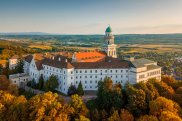
Hungary
Magyarország
Magyarország
Government type Parliamentary republic
Area 93,034 km˛ (35,921 sq mi)
Population 9,604,000 inh. (2022 census)
Population 9,585,000 inh. (2024 est.)
Population density 103 inh/km˛ (267 inh/mi˛)
Area 93,034 km˛ (35,921 sq mi)
Population 9,604,000 inh. (2022 census)
Population 9,585,000 inh. (2024 est.)
Population density 103 inh/km˛ (267 inh/mi˛)
Capital Budapest (1,686,000 pop., 2,407,000 urban aggl.)
Currency Hungarian forint
Human development index 0.846 (46th place)
Languages Hungarian
Life expectancy M 73 years, F 80 years
Currency Hungarian forint
Human development index 0.846 (46th place)
Languages Hungarian
Life expectancy M 73 years, F 80 years
GEOGRAPHY DATA OF HUNGARY
Largest cities
Budapest 1,686,000 pop., 2,407,000 urban aggl.
Debrecen 200,000 pop.
Szeged 159,000 pop.
Miskolc 148,000 pop.
Pécs 139,000 pop.
Gyor 128,000 pop.
Nyíregyháza 116,000 pop.
Kecskemét 108,000 pop.
Highest mountains
Kékes 1,014 m (3,327 ft)
Longest rivers
Danube 2,858 km (1,776 mi) total, 417 km (259 mi) in Hungary
Tisza 976 km (606 mi) total, 596 km (370 mi) in Hungary
Largest lakes
Balaton 594 km˛ (229 sq mi)
Neusiedl 285 km˛ (110 sq mi) total, 65 km˛ (25 sq mi) in Hungary
Largest islands
Csepel (in the Danube) 257 km˛ (99 sq mi)
ADMINISTRATIVE DIVISIONS OF HUNGARY
Hungary is divided into 19 provinces (megye), plus the district of the capital Budapest; Bács-Kiskun and Borsod-Abaúj-Zemplén are the two largest provinces, while Pest is the most populated after the capital district, with over 1 million inhabitants in both cases.There is only one large city in the country, Budapest, with 7 other urban centers over 100,000 inhabitants and with Debrecen just under 200,000 people; in each province, except in that of Tolna, there is at least one inhabited center with at least 30,000 inhabitants, with a fairly homogeneous distribution of cities and towns, even if the urban area of the capital alone accommodates 1/4 of the population.
Budapest
Photos
(click to enlarge)

Budapest and Danube

Pannonhalma Archabbey

Hortobágy
» See the full album
(12 photos)
Useful links
Hungarian Central Statistical OfficeVisit Hungary
